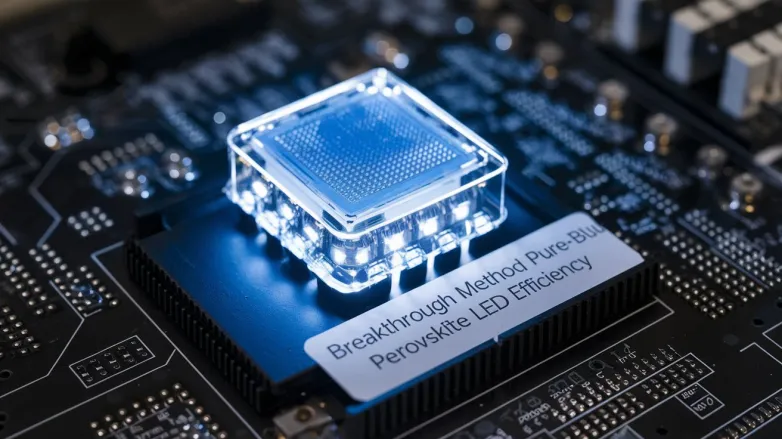Breakthrough Method Boosts Pure-Blue Perovskite LED Efficiency
- Soochow University researchers unveil a breakthrough in pure-blue PeLEDs, achieving superior efficiency and stability, transforming the future of light-emitting technologies with novel techniques.

Researchers at Soochow University have developed a novel method for creating efficient and stable pure-blue perovskite light-emitting diodes (PeLEDs) using in situ treatment of Cl-rich benzene phosphorus oxydichloride (BPOD). This approach enhances the perovskite bandgap while also passivating halide vacancy defects and immobilizing halide ions, addressing issues related to halide migration that hinder the performance of mixed halide PeLEDs.
Their findings present pure-blue PeLEDs achieving an external quantum efficiency (EQE) of 9.3% at 477 nm and a lifetime of 34.7 minutes at 104 cd m−2. The stability of the electroluminescence spectra achieved in their experiments surpasses that of traditional mixed halide PeLEDs, marking a significant enhancement in the quality and reliability of pure-blue emissions in this emerging technology.
How does the new method improve pure-blue perovskite light-emitting diodes' efficiency and stability?
- Improved Bandgap Engineering: The novel method utilizes Cl-rich benzene phosphorus oxydichloride (BPOD) to effectively tune the bandgap of the perovskite materials. This precise bandgap adjustment allows for optimal light absorption and emission in the blue spectrum, resulting in enhanced luminous efficacy and color purity.
- Defect Passivation: By employing in situ treatment, the BPOD process helps to passivate halide vacancy defects within the perovskite structure. These defects can decrease charge carrier mobility and overall device efficiency, so mitigating them directly contributes to better performance.
- Minimized Halide Migration: The method effectively immobilizes halide ions within the structure of the perovskite, reducing the detrimental effects of halide migration. This phenomenon often leads to phase segregation in mixed halide PeLEDs, which can severely impact long-term stability and performance.
- Enhanced Stability: The combination of bandgap tuning, defect passivation, and immobilization of halides leads to significantly improved stability of the electroluminescence spectra. The findings indicate that the pure-blue PeLEDs not only operate efficiently but also maintain their performance characteristics over time, outpacing the stability of traditional mixed halide counterparts.
- Extended Device Lifetime: The recorded lifetime of 34.7 minutes at a brightness of 104 cd m−2 demonstrates the durability of the new pure-blue PeLEDs. This longevity is pivotal for practical applications, where prolonged usage is essential in consumer electronics and displays.
- Higher External Quantum Efficiency (EQE): Achieving an EQE of 9.3% at 477 nm illustrates a significant step forward in maximizing light output for blue emissions. Higher EQE values are critical for applications in lighting and display technology, where efficiency is a major performance indicator.
- Application Potential: With enhanced efficiency and stability, these advancements open the door for pure-blue PeLEDs to be integrated into next-generation display technologies, such as microLEDs and OLEDs, thereby improving overall visual quality in consumer devices.
- Environmental Considerations: The method's success may also pave the way for further research on eco-friendly perovskite materials, as researchers explore alternatives to traditional mixed halide formulations that often involve toxic components.
- Future Research Directions: The insights gained from this novel approach may inspire new methodologies for creating other color-emitting perovskite diodes, potentially leading to the development of full-spectrum PeLEDs with even broader applications in the future.
These advancements in the development of pure-blue PeLEDs not only signify a potential revolution in light-emitting technology but also highlight the importance of innovative approaches in addressing historical challenges in the field.
Also read


